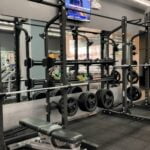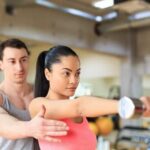As individuals reach the age of 50, prioritizing fitness becomes increasingly crucial for overall health and well-being. Engaging in regular exercise not only helps maintain physical strength and flexibility but also plays a significant role in promoting mental clarity and emotional well-being. In this article, we will explore the importance of staying fit at 50, highlighting the benefits of incorporating exercise into your daily routine to lead a healthier and more active lifestyle.
Exercise is essential for individuals over 50 as it can help improve cardiovascular health, increase muscle mass, enhance bone density, and boost metabolism. It is never too late to start an exercise routine or adapt your current one to better suit your needs as you age. By incorporating fit at 50 exercises into your lifestyle, you can reduce the risk of developing chronic conditions such as heart disease, diabetes, and arthritis while improving overall quality of life.
Despite common misconceptions about exercising at an older age, research has shown that regular physical activity can help older adults maintain independence, prevent falls, and reduce the risk of cognitive decline. Whether you are new to exercise or have been active for years, finding low-impact exercises suitable for individuals over 50 is key to preventing injury while still reaping the numerous health benefits associated with staying fit.
Benefits of Regular Exercise for Individuals Over 50
As individuals age, staying fit becomes even more crucial for maintaining overall health and well-being. Regular exercise has numerous benefits for individuals over 50, both physically and mentally. Engaging in physical activity can help improve cardiovascular health, reduce the risk of chronic diseases such as diabetes and hypertension, enhance bone density, and promote better balance and coordination. In addition to the physical benefits, exercise can also boost mood, mental clarity, and cognitive function.
Physical Benefits
Regular exercise at the age of 50 and beyond can help individuals maintain a healthy weight, increase muscle mass, and improve flexibility. It can also reduce the risk of falls by improving balance and coordination. Strength training exercises are particularly important for older adults as they can help prevent muscle loss and maintain bone density. Incorporating cardio exercises into one’s routine can also improve heart health and endurance.
Mental Benefits
Exercise is not only beneficial for physical health but also plays a significant role in mental well-being. Physical activity releases endorphins, which are known as “feel-good” hormones that can help reduce stress, anxiety, and symptoms of depression. Regular exercise has also been linked to improved cognitive function and a reduced risk of developing neurodegenerative diseases such as Alzheimer’s. Staying active at 50 can lead to a sharper mind and better overall quality of life.
Incorporating a variety of exercises into one’s routine is essential for reaping the maximum benefits of fitness at 50. By combining strength training, cardio exercises, flexibility workouts, and proper nutrition, individuals over 50 can maintain their health and vitality well into their golden years. It is never too late to start on the path to better health through regular exercise – with dedication and consistency, anyone can achieve their fitness goals even at 50 or beyond.
Common Misconceptions About Exercising at an Older Age
When reaching the age of 50, many individuals may start to believe in common misconceptions about exercising, leading them to avoid physical activity altogether. It is essential to debunk these myths and understand the importance of staying fit at 50 for overall health and well-being.
One of the most common misconceptions is that it is too late to start exercising at this age, but in reality, it is never too late to begin a fitness journey. Regular exercise can help improve strength, flexibility, and cardiovascular health, no matter what your age.
To further emphasize the benefits of staying fit at 50, let’s explore some key misconceptions that often deter individuals from prioritizing their physical fitness after reaching this milestone:
- Myth: Exercise is only for younger individuals
- Fact: People of all ages can benefit from regular physical activity
- Myth: Low-impact exercises are not effective
- Fact: Low-impact exercises can be just as beneficial for individuals over 50
- Myth: Strength training is unsafe for older adults
- Fact: Properly performed strength training can actually help prevent injuries and improve bone density
By addressing these misconceptions and understanding the importance of staying fit at 50, individuals can take proactive steps towards enhancing their overall quality of life. Remember that it is never too late to start prioritizing your health and well-being through regular exercise and proper nutrition.
- Incorporate a variety of exercises into your routine for optimal results
- Listen to your body and make adjustments as needed
- Consult with a fitness professional or healthcare provider for personalized guidance
Top 5 Low-Impact Exercises for Individuals Over 50
As individuals reach the milestone of turning 50, it becomes increasingly important to maintain a healthy and active lifestyle. Engaging in regular exercise is crucial for overall well-being, especially as we age. Low-impact exercises are particularly beneficial for individuals over 50 as they help prevent injuries, reduce joint stress, and improve cardiovascular health. Here are the top 5 low-impact exercises that can help you stay fit and healthy at 50:
- Walking: Walking is a simple yet effective way to stay active. It is gentle on the joints and can be easily incorporated into your daily routine. Aim for at least 30 minutes of brisk walking each day to reap the benefits of this low-impact exercise.
- Swimming: Swimming is an excellent full-body workout that is easy on the joints. It helps improve cardiovascular fitness, strength, and flexibility. Consider joining a water aerobics class or simply swim laps in the pool to stay in shape.
- Cycling: Cycling is a great low-impact exercise that can be done indoors or outdoors. It helps strengthen muscles, improve balance, and boost heart health. Whether you prefer riding a stationary bike or hitting the trails on a bicycle, cycling is a fun way to stay active at 50.
- Yoga: Yoga combines gentle movements with deep breathing techniques to promote relaxation and improve flexibility. It also helps build strength, balance, and focus. Consider taking a yoga class specifically designed for older adults to experience all the benefits of this ancient practice.
- Pilates: Pilates focuses on strengthening the core muscles while also improving posture and flexibility. This low-impact exercise can help alleviate back pain, increase muscle tone, and enhance overall body awareness. Joining a Pilates class led by a certified instructor can ensure proper form and technique.
Incorporating these top 5 low-impact exercises into your fitness routine after 50 can help you achieve better physical health, mental well-being, and quality of life as you age gracefully. Remember to listen to your body, start slowly, and gradually increase intensity to avoid any injuries while reaping the numerous benefits of staying fit at 50 exercises.
Incorporating Strength Training Into Your Fitness Routine After 50
As individuals reach the age of 50 and beyond, incorporating strength training into their fitness routine becomes increasingly important for overall health and well-being. Strength training helps maintain muscle mass, bone density, and balance, which are crucial in preventing age-related conditions such as osteoporosis and sarcopenia. While cardiovascular exercise is essential, adding resistance training can provide a myriad of benefits to promote a healthier lifestyle.
Benefits of Strength Training
Strength training not only increases muscle mass but also boosts metabolism, improves joint stability, and enhances overall functional strength. This type of exercise can help reduce the risk of falls by improving balance and coordination, ultimately leading to greater independence as individuals age. Additionally, strength training can alleviate symptoms of chronic conditions such as arthritis and back pain, making daily activities easier to perform.
Top 5 Strength Training Exercises
1. Squats: Squats are a compound exercise that targets multiple lower body muscles while also engaging the core for stability.
2. Push-ups: Push-ups work the chest, shoulders, triceps, and core muscles, helping to build upper body strength.
3. Lunges: Lunges strengthen the muscles in the legs and glutes while also improving balance and flexibility.
4. Planks: Planks engage the entire core area, including the abdominals and lower back muscles.
5. Dumbbell Rows: Dumbbell rows target the back muscles to improve posture and overall upper body strength.
By incorporating these strength training exercises into a fitness routine tailored for individuals over 50, one can experience improved physical function, increased energy levels, and a higher quality of life. Remember to start slowly with lighter weights or resistance bands if new to strength training and gradually increase intensity as strength improves over time.
Best Cardio Exercises for Staying Fit and Healthy at 50
With age, it becomes even more crucial to prioritize cardiovascular health to stay fit and healthy at 50. Cardio exercises are essential as they help improve heart health, boost metabolism, increase endurance, and promote overall well-being.
Engaging in regular cardio workouts can also reduce the risk of chronic diseases such as heart disease, diabetes, and obesity. By incorporating these exercises into your fitness routine, you can enhance your quality of life and maintain a high level of fitness even in your 50s.
One excellent cardio exercise for individuals over 50 is walking. It is low-impact, easy on the joints, and can be done virtually anywhere. Aim for brisk walking sessions of at least 30 minutes a day to get your heart rate up and burn calories effectively.
Swimming is another fantastic option for cardio that is gentle on the body while providing a full-body workout. The water’s buoyancy reduces strain on the joints, making it an ideal choice for those looking to improve cardiovascular health without risking injury.
Cycling is also a great form of cardio exercise that individuals over 50 can enjoy. Whether it’s cycling outdoors or using a stationary bike indoors, this activity helps strengthen the lower body muscles and improve cardiovascular fitness. Group cycling classes can add a social element to your workout routine while keeping you motivated. Remember always to consult with a healthcare provider before starting any new fitness regimen to ensure that these cardio exercises are suitable for your individual needs.
| Cardio Exercises | Benefits |
|---|---|
| Walking | Improves heart health, boosts metabolism, easy on joints |
| Swimming | Gentle full-body workout, reduces strain on joints |
| Cycling | Strengthens lower body muscles, improves cardiovascular fitness |
The Role of Flexibility Exercises in Maintaining Mobility at 50
Flexibility plays a crucial role in maintaining mobility as we age, especially once we reach the milestone of 50. Engaging in regular flexibility exercises can help improve range of motion, reduce stiffness, and enhance overall physical function. As part of a well-rounded fitness routine for individuals over 50, flexibility exercises should not be overlooked.
One of the key benefits of incorporating flexibility exercises into your fitness routine is the prevention of injuries. As we age, our muscles tend to tighten and joints may become less flexible, making us more susceptible to strains or sprains. By regularly stretching and engaging in flexibility exercises, you can help prevent such injuries and maintain your mobility for daily activities.
Some effective flexibility exercises for individuals over 50 include yoga, Pilates, tai chi, and simple stretching routines. These exercises not only help increase flexibility but also promote relaxation and stress relief. Additionally, combining flexibility exercises with strength training and cardio workouts can create a well-balanced fitness regimen that supports overall health and wellness.
| Flexibility Exercises | Benefits |
|---|---|
| Yoga | Improves range of motion and reduces stress |
| Pilates | Strengthens core muscles and enhances flexibility |
| Tai Chi | Promotes balance, coordination, and relaxation |
Tips for Creating a Personalized Workout Plan for Individuals Over 50
As individuals reach the age of 50 and beyond, it becomes increasingly important to create a personalized workout plan that caters to their specific needs and goals. The key to staying fit at 50 is not just about exercising regularly, but also about incorporating a variety of exercises that target different aspects of fitness. By creating a customized workout plan, individuals can ensure they are getting the most out of their exercise routine while minimizing the risk of injury.
When creating a personalized workout plan for individuals over 50, it is essential to take into consideration any existing health conditions or physical limitations. Consulting with a healthcare provider or fitness professional can help tailor the workout plan to address these specific needs. Additionally, including a mix of cardiovascular exercise, strength training, and flexibility exercises is crucial for overall health and well-being.
Incorporating low-impact exercises such as walking, swimming, or cycling can be beneficial for individuals over 50 who may have joint issues or reduced mobility. Strength training exercises using light weights or resistance bands can help maintain muscle mass and bone density, which tend to decline with age.
Flexibility exercises like yoga or Pilates can improve mobility and reduce the risk of falls. By combining these different types of exercises in a personalized workout plan, individuals over 50 can improve their overall fitness levels and maintain their health for years to come.
Importance of Proper Nutrition and Hydration for Individuals in Their 50s
As individuals reach their 50s, it becomes increasingly important to pay attention to proper nutrition and hydration in order to maintain overall health and well-being. Making healthier food choices and staying adequately hydrated can have a significant impact on one’s energy levels, mood, cognitive function, and physical fitness. A balanced diet rich in fruits, vegetables, whole grains, lean proteins, and healthy fats is essential for meeting the body’s changing nutritional needs as it ages.
Incorporating foods that are high in vitamins, minerals, and antioxidants can help boost the immune system and reduce the risk of chronic diseases commonly associated with aging. It is also crucial to stay hydrated by drinking an adequate amount of water throughout the day. Dehydration can lead to fatigue, muscle weakness, headaches, and even more serious health issues such as kidney stones or urinary tract infections.
When creating a personalized workout plan for individuals over 50, it is essential to include elements that support proper nutrition and hydration. Encouraging participants to eat a well-balanced diet tailored to their individual needs and to stay properly hydrated before, during, and after exercise sessions can enhance their overall physical performance and recovery.
By combining regular exercise with healthy eating habits and adequate hydration, individuals in their 50s can optimize their fitness levels and enjoy a higher quality of life.
Real-Life Success Stories of Individuals Who Transformed Their Health and Fitness at 50
As we have seen from the real-life success stories of individuals who transformed their health and fitness at 50, it is never too late to make positive changes and prioritize your well-being. These individuals serve as inspiring examples of the possibilities that can be unlocked through dedication and commitment to a healthy lifestyle.
By incorporating the right exercises, nutrition, and mindset, they were able to not only improve their physical health but also enhance their overall quality of life.
One common theme among these success stories is the emphasis on consistency and perseverance. Regardless of past habits or fitness levels, these individuals were able to make significant progress by staying dedicated to their workout routines and making sustainable changes in their lifestyles. Their achievements remind us that age is just a number, and with the right approach, anyone can achieve remarkable improvements in their health and fitness even after reaching 50.
The transformative journeys of these individuals highlight the importance of finding joy in the process of becoming fit at 50. Whether it’s through enjoyable low-impact exercises, challenging strength training routines, invigorating cardio workouts, or rejuvenating flexibility exercises, there are endless opportunities to stay active and maintain a healthy lifestyle as you age.
By taking inspiration from these success stories and implementing personalized workout plans tailored to individual needs, everyone has the potential to experience remarkable transformations in their health and fitness journey at 50 and beyond.
Frequently Asked Questions
Can You Reshape Your Body at 50?
Yes, it is possible to reshape your body at 50 through a combination of regular exercise, a healthy diet, and lifestyle changes. While it may be more challenging compared to when you were younger, with dedication and consistency, achieving fitness goals is definitely attainable.
What Is the Best Exercise for a 50 Year Old?
The best exercise for a 50-year-old largely depends on individual preferences, fitness level, and any underlying medical conditions. However, activities that combine cardio, strength training, flexibility, and balance exercises can be beneficial. It’s essential to find something enjoyable to stay motivated.
How Many Days a Week Should a 50 Year Old Work Out?
A 50-year-old should aim to work out most days of the week, preferably around 4-5 days. This frequency allows for adequate recovery time while still reaping the benefits of consistent exercise. It’s crucial to listen to your body and adjust according to your own needs and limitations.

Passionate about providing useful information to anyone with an interest in the field of Personal Training, I strive to pass on to our readers quality information and to answer any questions about Personal Trainers, the work they do and how to become one.





